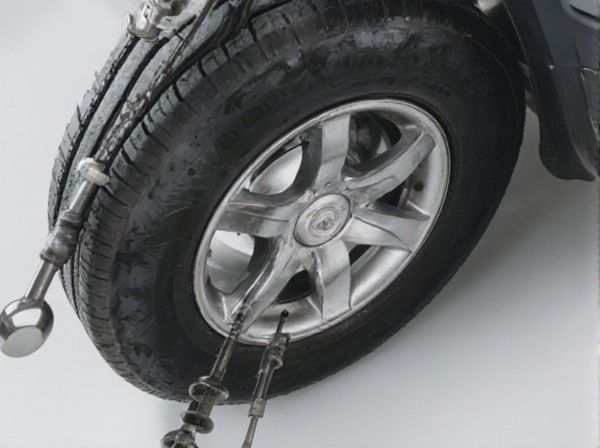
Photo illustration: Reverse Cut Axle vs Standard Cut Axle
Reverse Cut axles feature gears oriented to improve strength and durability in vehicles running larger tires or experiencing higher torque, making them ideal for off-road use. Standard Cut axles have gears cut for efficiency and smoother operation, best suited for lower torque applications and everyday driving. Choosing between the two depends on your vehicle's power demands and terrain, ensuring optimal performance and longevity.
Table of Comparison
| Feature | Reverse Cut Axle | Standard Cut Axle |
|---|---|---|
| Gear Orientation | Pinion gears mesh on the reverse side for added strength | Pinion gears mesh on the standard side |
| Durability | Higher durability, ideal for high torque and off-road applications | Less durable under extreme conditions |
| Application | Common in heavy-duty, off-road, and performance vehicles | Widely used in factory standard and mild-duty setups |
| Cost | Generally more expensive due to specialized manufacturing | More affordable and easier to replace |
| Strength | Handles higher torque loads with reduced risk of gear stripping | Suitable for moderate torque demands |
| Noise Level | Typically quieter operation due to better gear engagement | May produce more gear noise under load |
Introduction to Axle Types
Reverse cut axles feature gears oriented to provide increased strength and durability, making them ideal for heavy-duty vehicles and off-road applications. Standard cut axles have gears cut in a traditional manner, offering smoother performance and are commonly used in everyday passenger vehicles. Understanding the differences in gear orientation and strength between these axle types is essential for selecting the right axle based on vehicle use and performance needs.
What Is a Standard Cut Axle?
A standard cut axle refers to an axle that is evenly cut off at the end, providing a smooth and consistent surface for the wheel hub to mount onto. This design ensures compatibility with typical brake setups and wheel bearings, maintaining proper alignment and structural integrity during vehicle operation. Standard cut axles are commonly used in rear-wheel drive vehicles and serve as a reliable option for conventional suspension systems.
What Is a Reverse Cut Axle?
A reverse cut axle is designed with gears that mesh in the opposite direction of a standard cut axle, providing increased strength and better durability under high torque conditions. Commonly used in the front axles of solid front axles in off-road vehicles and trucks, reverse cut axles improve gear engagement and reduce noise. Their unique gear design allows for smoother operation during steering and off-road maneuvers compared to standard cut axles.
Key Differences Between Standard and Reverse Cut Axles
Reverse cut axles feature gears with opposite tooth orientation designed to handle torque direction from the ring gear more efficiently, improving strength and noise reduction in front-wheel drive and four-wheel drive systems. Standard cut axles have gears cut to manage torque in rear-wheel drive setups, making them more common but less ideal for front differential configurations. The key difference lies in gear tooth design and torque application, where reverse cut axles offer enhanced durability and smoother operation in specific drivetrain layouts compared to standard cut axles.
Application Scenarios: Where Each Axle Excels
Reverse cut axles excel in low-speed, high-torque applications such as rock crawling and off-road trails where enhanced strength and durability against axle wrap are crucial. Standard cut axles perform best in high-speed, on-road scenarios like street cruising and racing due to their smoother engagement and lighter weight, improving efficiency and driveline response. Choosing the right axle depends on the vehicle's primary use, balancing toughness for rugged terrain against performance benefits on paved surfaces.
Performance Considerations: Strength and Durability
Reverse cut axles feature a gear orientation that enhances strength and durability under extreme torque conditions, making them ideal for heavy-duty applications. Standard cut axles, while generally sufficient for moderate loads, may experience accelerated wear when subjected to high stress due to their gear design. Performance comparisons highlight reverse cut axles as superior in withstanding shock loads and maintaining reliability in off-road and racing environments.
Off-Road vs On-Road: Axle Selection Impact
Reverse cut axles feature gears oriented to handle torque more efficiently for off-road conditions, providing increased strength and durability on rough terrain. Standard cut axles are optimized for on-road use, delivering quieter operation and better performance at higher speeds with less wear. Choosing between these axle types affects vehicle reliability and handling, with reverse cuts ideal for rugged off-road environments and standard cuts suited for daily street driving.
Compatibility with Differential Setups
Reverse cut axles are designed specifically for vehicles with front-engine, front-wheel-drive configurations, providing compatibility with reverse-rotation differentials common in off-road and performance applications. Standard cut axles suit rear-wheel-drive or traditional front-engine setups, aligning with conventional differential rotations to ensure proper gear meshing and durability. Selecting the correct axle type guarantees optimal drivetrain efficiency and minimizes premature wear due to improper gear alignment or incompatible differential rotations.
Cost and Maintenance Comparison
Reverse cut axles generally cost more upfront than standard cut axles due to their specialized design and manufacturing process. Maintenance expenses for reverse cut axles tend to be lower because they experience less stress and wear during operation, extending component lifespan. Standard cut axles often require more frequent servicing and part replacements, which can increase long-term maintenance costs despite their lower initial price.
Choosing the Right Axle for Your Vehicle
Choosing the right axle for your vehicle depends on factors such as load capacity, durability, and application type. Reverse cut axles offer increased strength and better gear mesh, making them ideal for off-road and heavy-duty use, while standard cut axles provide smoother gear engagement suited for everyday driving conditions. Consider your vehicle's intended use, terrain, and performance requirements to select the axle that maximizes reliability and efficiency.
 caratoz.com
caratoz.com